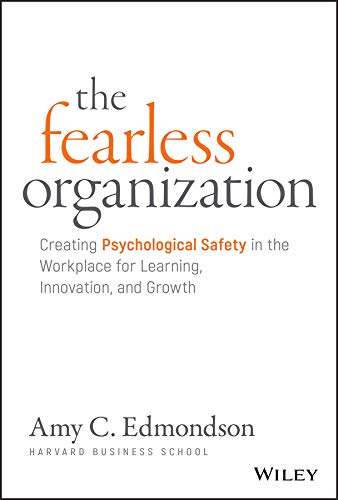In 1986, W. Edwards Deming introduced his “14 Points for Management” in the book, Out of the Crisis. Here is number eight.
“Whether fear of failure, fear of reprisals or fear of management, fear is unhelpful to the success of your business. Drive out fear by encouraging communication, respect and teamwork at all levels of your business.”
That was good advice, but there wasn’t much guidance on how to drive out fear or how your workplace might function when you did. Amy Edmonson’s The Fearless Organization gives you a mental model, so you know what an organization looks like after you follow Dr. Deming’s advice to “Drive out fear.”
I’ve read a lot about “psychological safety” in the past several years, including several articles by Dr. Edmondson. Since she coined the term, many other people have used it. I bought this book to go to the source and find out what Dr. Edmondson had to say.
She describes her goal for the book in the Introduction. She wants to “equip you with some new ideas and practices to make knowledge-intensive organizations work better.” She defines the fearless organization this way.
“The fearless organization is one in which interpersonal fear is minimized so that team and organizational performance can be maximized in a knowledge intensive world.”
The Fearless Organization is divided into three parts. Part I is, “the power of psychological safety.” Chapter two is an excellent summary of the research. If you’re interested in going into more depth about psychological safety, this chapter is worth the price of the book. In addition to this chapter on research, Dr. Edmondson includes detailed notes and references at the end of every chapter. Minor these at your pleasure.
Part II is “Psychological Safety at Work.” Chapters three and four give you real-world examples of organizations without psychological safety. You’ll recognize most of them. Chapters five and six share examples of organizations with psychological safety. You may be surprised at some of them. You will see a strong contrast between the two groups in terms of organizational life and productivity.
Pare III is “Creating a Fearless Organization.” Chapter seven provides a toolkit for leaders. The tools fall into three buckets. They are, setting the stage, inviting participation, and responding productively. If you want to follow Dr. Deming’s advice to drive out fear, here’s how.
Chapter eight is titled, “What Next.” It includes an excellent section on the questions Dr. Edmondson is frequently asked about psychological safety.
This is an excellent book, whether you’re investigating psychological safety as an intellectual exercise or seeking some help in improving psychological safety where you work. The big insight for me was that psychological safety deals with interpersonal fear and is an emergent property of a group. I had the basic concepts, but now I have deeper insights and language to express them.
This is a good, helpful package of important ideas. But they may not seem new to you. You probably know that it’s not a good idea to shoot messengers who bring bad news. You may understand your job as creating an environment where both productivity and morale are high. Don’t pass up this book on that account.
First, no matter how much you know, you can learn something here about psychological safety., Just knowing isn’t enough. As my friend Rod Santomassimo likes to say, “Don’t KID yourself, knowing isn’t doing.” This book can be a powerful tool to improve the work and morale of any team. But that won’t happen if all you do is read about psychological safety.
In a Nutshell
The Fearless Organization demonstrates what psychological safety is, why it’s important, and how to make it happen where you work. If you’re responsible for the performance of the group, put this book on your must-read list.
Good Companion Reads
Now You’re the Boss by Wally Bock
‘Your job as a boss is to create a great working environment for your team.”
The Coaching Habit by Michael Bungay Stanier
Growing Great Employees: Turning Ordinary People into Extraordinary Performers by Erika Andersen
Humble Leadership: The Power of Relationships, Openness, and Trust by Edgar Schein and Peter Schein
You can check out some of my highlights and notes from this book on GoodReads.
-o0o-
What’s the fastest way to learn the big ideas from a great business book? Book summaries. Check out summaries from The Business Source, where you can watch, read, or listen to the big ideas from a great book in under 20 minutes.



There are no comments yet, why not be the first to leave a comment?